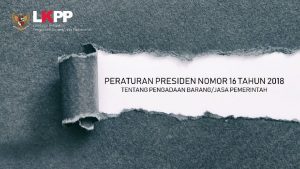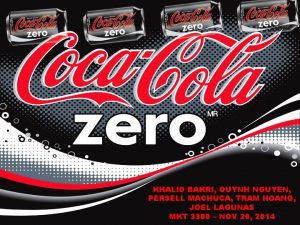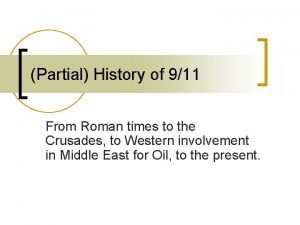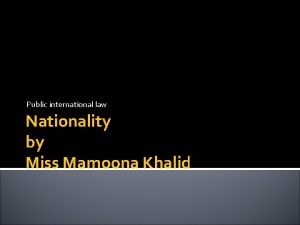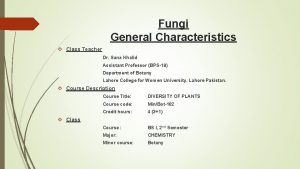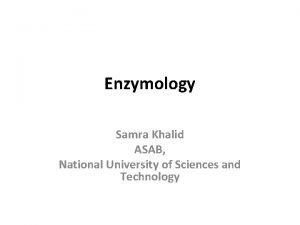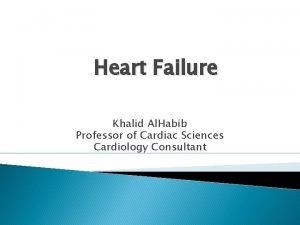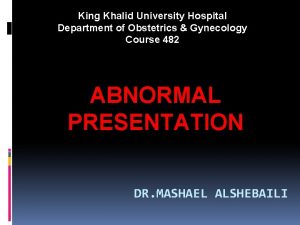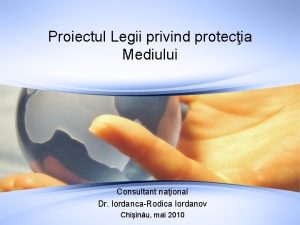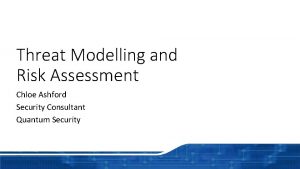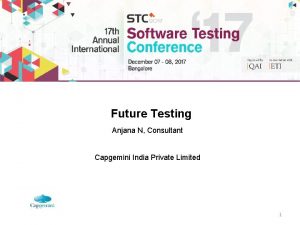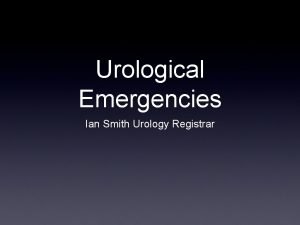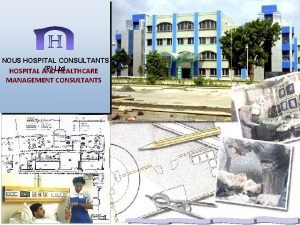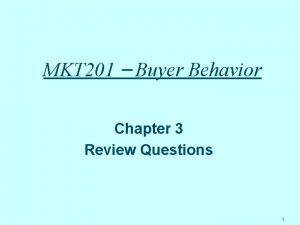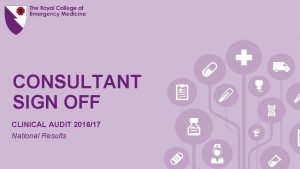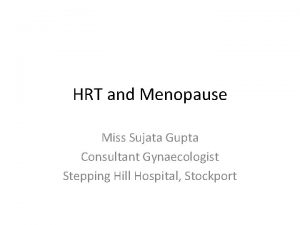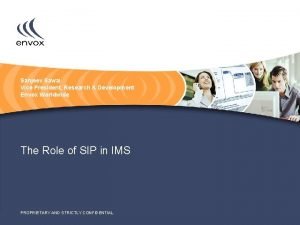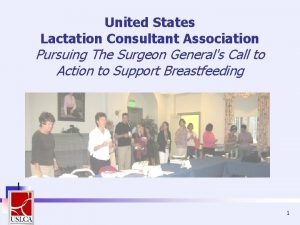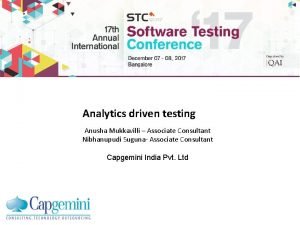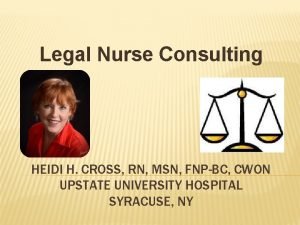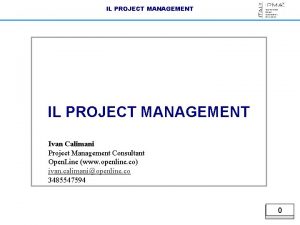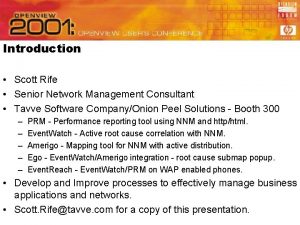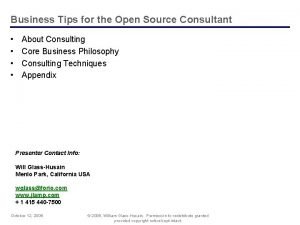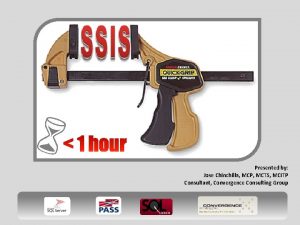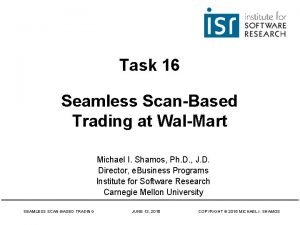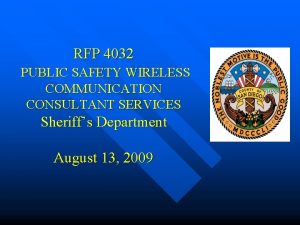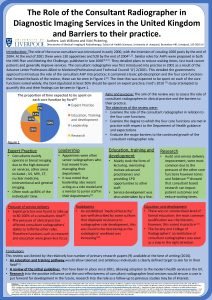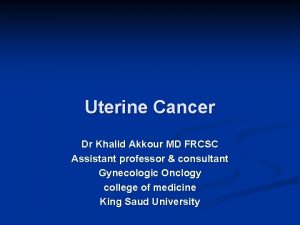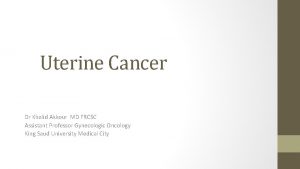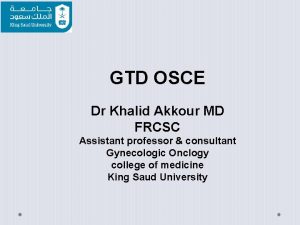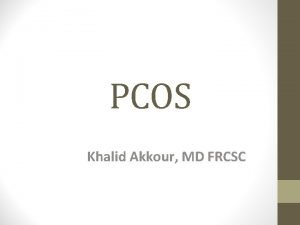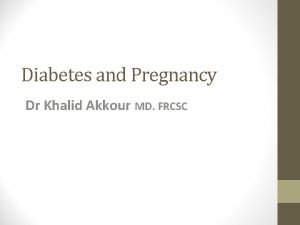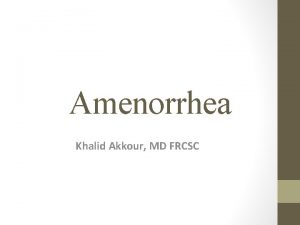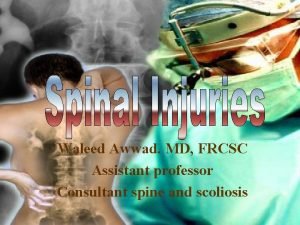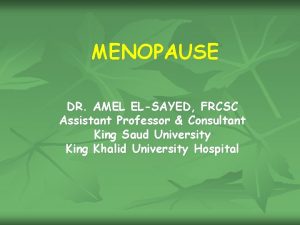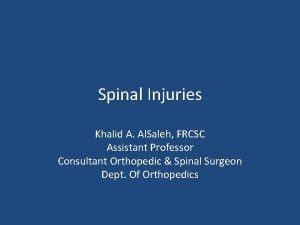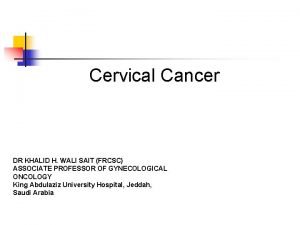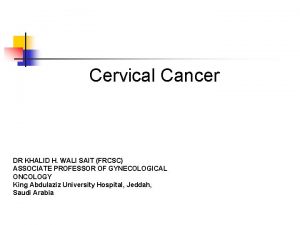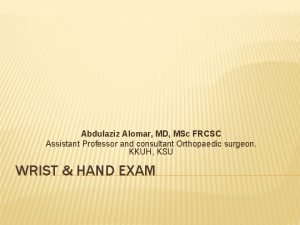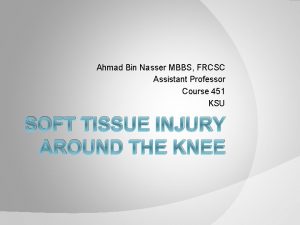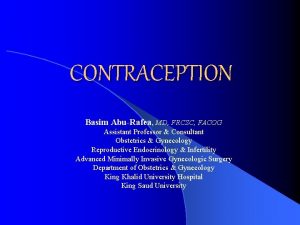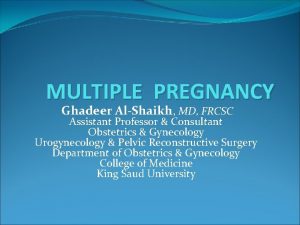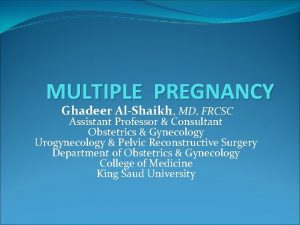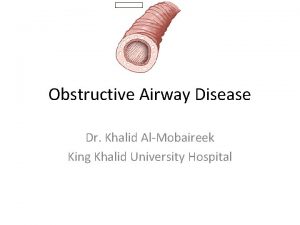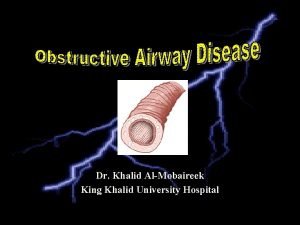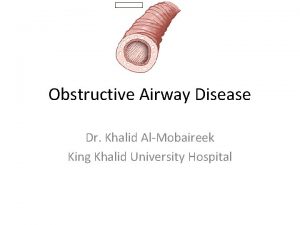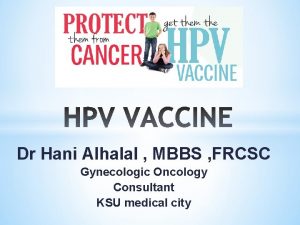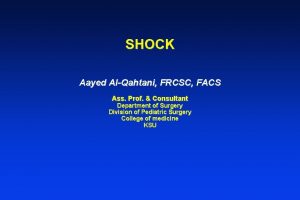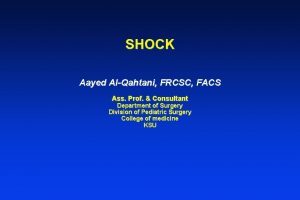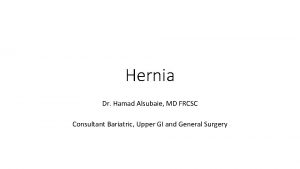Dr Khalid Akkour MD FRCSC Assistant professor consultant




































































- Slides: 68

Dr Khalid Akkour MD FRCSC Assistant professor & consultant Head of Gynecologic Onclogy College of medicine King Saud University

1. WHAT IS HPV 2. HPV RELATED INFECTIONS 3. PREVELANCE IN U. S AND SAUDI ARABIA 4. TYPES OF VACCINES AVILABLE 5. TIME OF VACCINATION 6. DOSES AND ADMINISTRATIONS 7. DURATION OF PROTECTION 8. SAFETY OF THE VACCINE

Human papillomavirus üDNA virus from the papillomavirus family üover 150 types are known üMore than 40 types are transmitted through sexual contact and infect the anus and genitals. ü spread by sustained direct skin-to-skin contact with vaginal and anal sex üIt does not spread via common items like toilet seats ücannot be cultured without living tissue



DISEASE ASSOCIATIONS: v. HPV-related disease in females Ø Cervical cancer and precursor lesions -is the third most common female cancer worldwide -IN U. S -THE ESTIMATED ANNUAL INCIDENCE OF CIN AMONG FEMALE WHO UNDERGO CERVICAL CANCER SCREENING IS 0. 4 % FOR CIN 1 AND 0. 5% FOR CIN 2/3 -HPV TYPE 16 AND 18 cause approximatily 70% of cervical cancer and 50 % of precancerous cervical lesions -HPV types 31, 33, 45, 52, and 58 are estimated to cause an additional 19 % of invasive cervical cancers

in Saudi Arabia: ØIn Saudi Arabia which has a population of 8 million women over the age of 15 years, approximately 152 new cases of CC are diagnosed every year Ø 55 women die from the disease annually Øranking number 12 between all cancers in females ØAccounts for 2. 4% of all new cases, despite the lack of national screening programs.


• This was an observational, epidemiological cross-sectional study conducted between April 2010 and December 2011 at three hospitals in Saudi Arabia

• Result : 1. The overall prevalence of HPV was 9. 8% in Saudi Arabia, but was higher in women over 55 years, as well as in non-Saudi nationals. 2. The most prevalent HR-HPV-types were: HPV-68/73 –--(5 cases) HPV-18 ----(4 cases) HPV-16 (3 cases) The most prevalent low risk types were HPV-6 -- (4 cases) HPV-42, HPV-53 and HPV-54 (2 cases each).


Ø 100 patients with histo pathologically proven, locally advanced, cervical cancer were enrolled in this study out of 218 patients followed at KFSHRC from 2009 to 2012. ØThere was no restriction on patients’ age or histological type of cervix cancer

Conclusions ØThe prevalence of HPV infection in invasive cervical cancer in Saudi Arabia (82%) is at the lower range of that observed in the world (85%-99%) Øthe most common HPV genotype was HPV-16 (71%), followed by HPV-31 (7%), HPV-18, 45, and 73 (4% each) Ø double infections were present in 8. 5% of HPV-positive patients.

v. The Departments of Obstetrics and Gynecology, and Histopathology at KKUH conducted A retrospective study. vreviewed all cervical pap smears obtained from Saudi women between the years of 2004 and 2014. v found that the frequency of epithelial cell abnormalities in the cervix among Saudi women is relatively low. v. The mean age of cervical carcinoma was 61 years, which is higher than the one reported in western countries. vrelatively high incidence of invasive Cancer, which is found in older Saudi women, suggest that the starting age of cervical screening in our society should be from 25 years with continuation of the screening till after 65 years of age.

ØVulvar and vaginal cancer and precursor lesions — ØRelatively rare cancers globally IN U. S Øestimated incidence of 27, 000 vulvar cancers and 13, 000 vaginal cancers in 2008 Ø the attributable fraction due to HPV infection has been estimated to be 43 % for vulvar and 70 % for vaginal cancer

v. HPV-related disease in females and males ØAnal cancer and precursor lesions — • Relatively rare cancer globally • HPV types 16 and 18 cause around 70 to 85 % of anal cancers and precancerous lesions (ie, anal AIN grade 2 and grade 3

ØGenital warts — • HPV types 6 and 11 cause 90 percent of genital warts. • IT is associated with physical and psychological morbidity and have a high rate of treatment failure AND treatment of recurrent episodes is costly

ØOro-pharyngeal cancer — • HPV infection may also play a role in the pathogenesis of squamous cell carcinomas of the head and neck. • primarily found in the oropharynx and base of the tongue , tonsil AND larynx

v. HPV-related diseases in males ØPenile cancer and precursor lesions — • It is rare globally • HPV 16 and HPV 18 cause approximately 35 to 40 % of penile cancers and 70 -80 % of HPV-positive penile cancers

1989 HPV VACCINE?

§ Ian Hector Frazer § born 6 January 1953 § is a Scottish-born Australian scientist § He met with virologist Jian Zhou the two considered the problem of developing a vaccine for HPV

U. S FDA Approved ? 2006

Saudi Food and Drug Administration approved prophylactic HPV vaccine in 2010

Three different vaccines have been developed against HPV :


üa quadri-valent HPV vaccine, targets HPV types 6, 11, 16, and 18 üIt is approved for the prevention of cervical cancer and cervical and vulvar intra epithelial neoplasia in young women üapproved for both men and women from the ages of 9 to 26 for the prevention of genital warts, anal cancers, and anal intraepithelial neoplasias.

ØTwo large, randomized, double-blind, placebocontrolled trials have evaluated the efficacy of this vaccine in more than 17, 000 adolescents and young females : 1. Among HPV-naïve populations, the efficacy for preventing CIN 2 or more severe disease due to HPV types included in the vaccine, was 97 to 100 %

2. In the overall population of study participants (with or without prior HPV infection), the efficacy of the vaccine for preventing CIN 2, or more severe disease due to HPV types included in the vaccine was significantly lower at approximately 44 % after a mean follow-up period of 3 years. This reduction in efficacy reflects the fact that the vast majority of enrollees in this trial were already sexually active and many had been previously infected with vaccine HPV types The National Cancer Institute Reviewed: November 2, 2016


üa 9 -valent vaccine, targets the same HPV types as the quadri- valent vaccine (6, 11, 16, and 18) as well as types 31, 33, 45, 52, and 58. üAn international trial reported the efficacy of this vaccine in approximately 14, 000 females aged 16 to 26 years who were randomly assigned to receive the vaccine : 1. Among HPV-naïve populations, the efficacy of 9 -valent vaccine for preventing CIN 2 or more severe disease, VIN 2 or 3, and Va. IN 2 or 3 associated with HPV types 31, 33, 45, 52, and 58 was 97 % The National Cancer Institute Reviewed: November 2, 2016

2. In the overall population of study participants (with and without prior HPV infection), the rates of high-grade cervical, vaginal, and vulvar disease were the same among women who received the 9 -valent vaccine and those who received the quadri-valent vaccine (14 cases/1000 person years in both groups).

-a bivalent vaccine, targets HPV types 16 and 18 -is approved for girls and women aged 9 to 25 for the prevention of cervical cancer and CIN.

ØOne large randomized clinical trial in more than 18, 000 young females aged 15 to 25 years demonstrated the efficacy of bivalent HPV vaccine. • Among HPV-naïve patients, the efficacy of the vaccine for preventing CIN 2 or more severe disease due to HPV types included in the vaccine was 93 %

• In the overall population of study participants (with and without prior HPV infection), vaccine efficacy for preventing CIN 2 or more severe disease due to HPV types included in the vaccine was significantly lower at 53 % after a mean follow-up period of approximately 3 years. * The National Cancer Institute Reviewed: November 2, 2016

When?

American Cancer Society (ACS) guidelines should be routinely offered to 1. females aged 11 to 12 years; immunization may begin at 9 years of age. 2. catch-up vaccination for females aged 13 to 18 who have not been previously vaccinated or completed their vaccine series. 3. The ACS notes that there is insufficient evidence to recommend for or against vaccination of females aged 19 to 26 years.

The World Health Organization (WHO) 1. suggests that girls within the age range of 9 through 13 years should be the primary target population for HPV immunization. 2. local public health programs should recommend vaccination of older females only if it is affordable and cost effective and does not divert resources from vaccinating the primary target population or screening for cervical cancer.


Conclusion: Knowledge and perception of HPV infection as an STDS and its vaccine was significantly low in this cohort of patients. Higher age and educational levels directly correlated with increased knowledge of HPV infection and its complications. It is recommended that awareness should be raised, and access to HPV vaccination increased to help reduce the health care burden of HPV sequelae in the Kingdom.

IMMUNIZATION IN SPECIAL PATIENT POPULATIONS

What about ? Pregnant females?

According to CDC RECOMMENDATIONS ünot recommended given that safety in this setting has not been thoroughly evaluated. üIf a woman is found to be pregnant after initiating the vaccination series, the remainder of the three-dose regimen should be delayed until after completion of the pregnancy

ØIn quadri valent HPV vaccine trials, the composite rate of adverse pregnancy outcome (spontaneous abortion, late fetal death, congenital anomaly) was similar for the 3819 females who became pregnant and controls who did not receive the vaccine (22. 6 versus 23. 1 percent) ØSimilarly reassuring findings have been reported for the bivalent HPV vaccine and for the 9 -valent HPV vaccine , although data are more limited ØSafe in lactating females as it dose not affect the infant breast feeding

Immunization in females with pre -existing cervical abnormalities or genital warts

ØA history of genital warts, abnormal cytology, or +VE HPV DNA test result is not evidence of prior infection with any or all of the vaccine HPV types Øvaccination can still provide protection against infection with HPV vaccine types not already acquired. Øassessment with Pap testing or screening for existing HPV infection is NOT indicated as part of the determination for HPV vaccine candidacy. Øthese patients should be advised that vaccination will have no therapeutic effect on pre-existing HPV infection or CIN , and the potential benefit of HPV vaccination is not as great as if they were vaccinated before they started having sex.

Transplant recipients and HIVinfected patients

v. Studies of the HPV quadrivalent vaccine in HIVinfected adult men and women aged 16 to 23 years , boys and girls aged 7 to 12 years suggest that it is both immunogenic and safe in these populations. vefficacy data are not yet available.

v. For solid organ transplant recipient It is safe to be given 3 to 6 months following trasplantation

PREVACCINATION ASSESSMENT The Advisory Committee on Immunization Practices(ACIP) does not recommend serologic or HPV DNA testing prior to immunization in females or males

VACCINE DOSE AND ADMINISTRATION According To CDC GUIDELINES ON DEC 2016 Immunization schedule — In the United States, as of 2016, the recommended dosing schedule depends on the age of the patient • Individuals younger than 15 years should receive two doses of HPV vaccine at least six months apart.

Individuals 15 years or older should receive three doses of HPV vaccine over a minimum of 24 weeks. • The minimum interval between the first two doses is 4 weeks and the minimum interval between the second and third doses is 12 weeks. • The Gardasil and Gardasil 9 are typically administered in three doses at time zero, and at two and six months of follow-up. • Cervarix follow a similar three-dose schedule for those older than 15 years, the bivalent vaccine is typically administered in three doses at time zero, and at one and six months of follow-up.

Interrupted schedules if the vaccination series is interrupted for any length of time, it can be resumed without restarting the series.

For how long ? Duration of protection ?

v. IN ALL CLINICAL TRIALS Persistent antibody levels and protection against HPV infection have been reported up to 10 years following vaccination. v. Of note, the precise level of antibody needed for protection against infection is unknown. v. Further data will become available in the future as female and male participants in vaccine studies are followed over time. *


Results: v HPV-16 and -18 antibodies peaked at Month 7 and gradually plateaued at Months 18– 24 and remained stable through 6. 4 years v Mean antibody levels at the last time point were several fold higher than those associated with natural infection. v. The study predict that HPV-16 and -18 mean antibody levels will remain well above those associated with natural infection for at least 20 years

Vaccine safety

All vaccines use virus-like particles (VLPs) which mimic the viral capsid. VLPs do not contain genetic material and are produced in biologic systems, which have wellestablished safety records

Quadrivalent vaccine (Gardasil) Prelicensure trial data The safety profile of the quadri valent vaccine was evaluated in diverse populations of females from resource-rich and resource-limited settings. Mild injection site reactions were the most commonly observed adverse events The safety profile of quadrivalent vaccine in males was reported to be similar to that of studies in females

Postlicensure data v In the U. S, adverse events following immunization are collected analyzed within the Vaccine Adverse Event Reporting System (VAERS) v. Adverse events following HPV vaccine are compared with background rates following other immunizations. v. Between June 2006 and March 2013, approximately 57 million doses of quadrivalent HPV vaccines were distributed v. Reports of adverse events to VAERS have been consistent with the pre-licensure data: v. From 2006 to 2013, VAERS received 21, 194 reports of adverse events following HPV immunization among females The vast majority (92 %) were considered mild. The proportion of events reported as serious peaked in 2008

v. Among serious events, headache, nausea, vomiting, fatigue, dizziness, syncope, and generalized weakness were the most frequently reported. v There is no increased risk of Guillain-Barré Syndrome compared with other vaccines in similar age groups v. Through 2011, 72 post-vaccination deaths had been reported, of which 34 were confirmed. There was no unusual pattern or clustering to the deaths that would suggest that they were caused by the vaccine

v. VTE rates reported to the VAERS were higher for quadrivalent vaccine than other vaccines, of the 31 patients with thromboembolism reported through 2008, 90 % had a known risk factor (ie, estrogen-containing birth control pills or a family history of clotting disorder v. Anaphylaxis had also been reported following administration of the quadrivalent vaccine

9 -valent vaccine (Gardasil 9) In an analysis of seven trials in which over 15, 000 individuals received at least one dose of the 9 -valent vaccine, the most common adverse effects were: 1. mild or moderate injection site reactions (pain, erythema, and swelling) more frequently than with the quadrivalent vaccine. 2. systemic adverse effects (eg, headache, fever, nausea, dizziness) were similar with the 9 -valent and quadrivalent vaccines. 3. Serious adverse effects occurred in <0. 1 percent.

Bivalent vaccine (Cervarix) In a phase III, multinational prospective, double-blind, placebo-controlled trial of more than 18, 000 females aged 15 to 25 years, the vaccine was well tolerated and there were no differences in serious adverse events between vaccine and placebo recipients. Because of low uptake of the bivalent vaccine in the U. S only sparse post-licensure data are available. As of September 2011, there have been 52 VAERS reports of adverse events following administration of bivalent vaccine and the majority (98%) were considered non serious.

COST EFFECTIVENESS Mathematical models have examined the cost effectiveness of HPV vaccination One study suggested that vaccination of the entire United States population of 12 -year-old girls would annually prevent >200, 000 HPV infections 100, 000 abnormal cervical cytology examinations 3300 cases of cervical cancer if cervical cancer screening continued as currently recommended

A small massage to take her is v-HPV vaccination appears to be safe and effective in preventing subsequent infection in older women, but the overall benefit is less than that in younger females v-the need to vaccinate individuals before the onset of sexual activity to gain the greatest benefit and maximize cost effectiveness.

-None of the three vaccines treats or accelerates the clearance of pre-existing vaccine -type HPV infections or related disease.

 Cuhk salary scale 2020
Cuhk salary scale 2020 Promotion from assistant to associate professor
Promotion from assistant to associate professor Khalid mustafa
Khalid mustafa Welcome to english class
Welcome to english class Dr khalid waheed
Dr khalid waheed Khalid bakri
Khalid bakri Nauman khalid md
Nauman khalid md Arzoo khalid
Arzoo khalid Sana khalid
Sana khalid 911 in roman
911 in roman Khalid nationality
Khalid nationality Khalid bazaid
Khalid bazaid Complete the tag question your name is ali khalid
Complete the tag question your name is ali khalid Fariza khalid
Fariza khalid Dr sana khalid
Dr sana khalid Jurnal jamal
Jurnal jamal Fariza meaning
Fariza meaning Khalid farhan course google drive
Khalid farhan course google drive Cherki karkaba
Cherki karkaba Khalid al dossary
Khalid al dossary Samra khalid
Samra khalid Khalid karaoui
Khalid karaoui Khalid alsadhan
Khalid alsadhan Khalid al habib
Khalid al habib Brow presentation birth
Brow presentation birth Khalid bazaid
Khalid bazaid Consultant mediu
Consultant mediu Behavioral genetics consultant
Behavioral genetics consultant Threat modelling consultant
Threat modelling consultant Palo alto certified network security engineer
Palo alto certified network security engineer Professional indemnity insurance for an export consultant
Professional indemnity insurance for an export consultant Acat imt
Acat imt Test consultant capgemini
Test consultant capgemini Consultant forensic psychiatrist
Consultant forensic psychiatrist Verizon sip trunk
Verizon sip trunk Dr dan rogers
Dr dan rogers Sustainable tourism consultant jobs
Sustainable tourism consultant jobs Associate consultant in capgemini
Associate consultant in capgemini Dartos tissue
Dartos tissue Expert in consultant liaison psychiatrist
Expert in consultant liaison psychiatrist Ellucian banner upgrade consultant
Ellucian banner upgrade consultant Stuart minty
Stuart minty Nous hospital consultant
Nous hospital consultant Claudia norman a marketing consultant
Claudia norman a marketing consultant Rcem consultant sign off
Rcem consultant sign off Dr sujata gupta gynaecologist
Dr sujata gupta gynaecologist Neurologist northern ireland
Neurologist northern ireland Mis consultant
Mis consultant Assertivel
Assertivel Doing business with fdot
Doing business with fdot Stake temple and family history consultant
Stake temple and family history consultant Sanjeev sawai
Sanjeev sawai United states lactation consultant association
United states lactation consultant association Module engineering consultant
Module engineering consultant Associate consultant in capgemini
Associate consultant in capgemini Court security consultant
Court security consultant Legal nurse consultant report template
Legal nurse consultant report template Principal consultant significato
Principal consultant significato Talent acquisition consultant philips
Talent acquisition consultant philips Ovtopodump
Ovtopodump Judith james educational consultant
Judith james educational consultant Open source consultant
Open source consultant Green world international training center
Green world international training center Ayurvedic lifestyle consultant
Ayurvedic lifestyle consultant Mcts mcitp
Mcts mcitp Epicor configurator demo
Epicor configurator demo Scan based trading data
Scan based trading data Wireless communication consultant
Wireless communication consultant What is a consultant radiographer
What is a consultant radiographer


